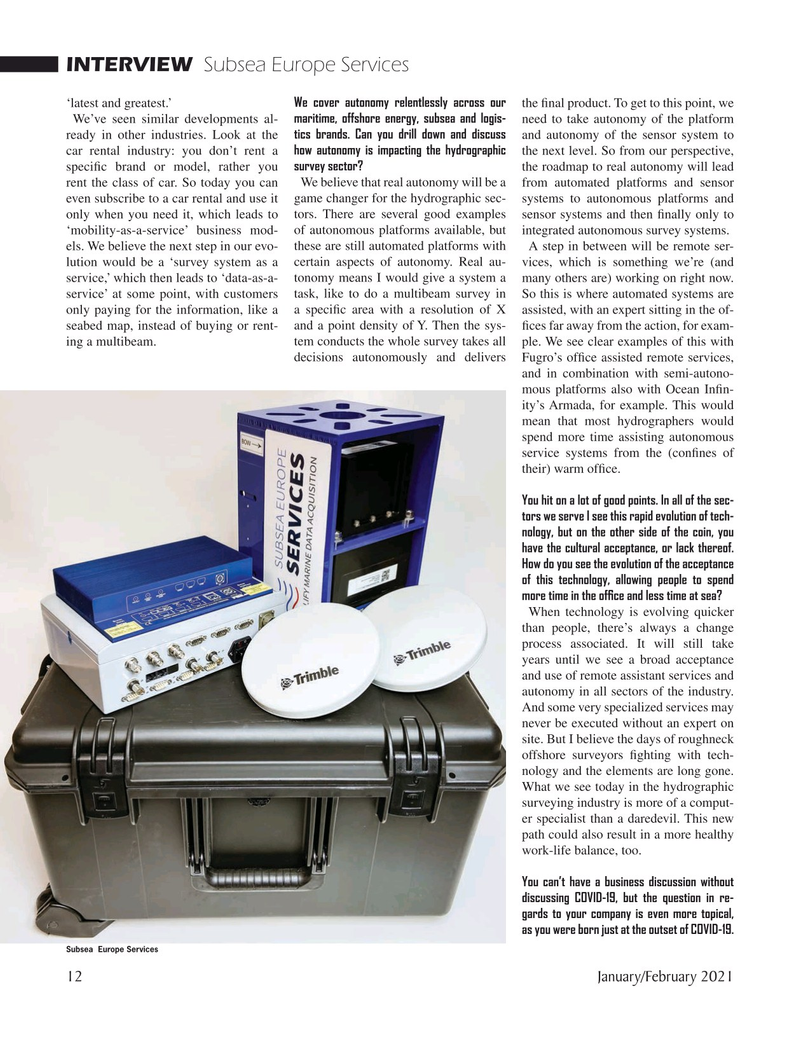
Page 12: of Marine Technology Magazine (January 2021)
Underwater Vehicle Annual
Read this page in Pdf, Flash or Html5 edition of January 2021 Marine Technology Magazine
INTERVIEW Subsea Europe Services ‘latest and greatest.’ We cover autonomy relentlessly across our the ? nal product. To get to this point, we
We’ve seen similar developments al- maritime, offshore energy, subsea and logis- need to take autonomy of the platform ready in other industries. Look at the tics brands. Can you drill down and discuss and autonomy of the sensor system to car rental industry: you don’t rent a how autonomy is impacting the hydrographic the next level. So from our perspective, speci? c brand or model, rather you survey sector? the roadmap to real autonomy will lead rent the class of car. So today you can We believe that real autonomy will be a from automated platforms and sensor even subscribe to a car rental and use it game changer for the hydrographic sec- systems to autonomous platforms and only when you need it, which leads to tors. There are several good examples sensor systems and then ? nally only to ‘mobility-as-a-service’ business mod- of autonomous platforms available, but integrated autonomous survey systems.
els. We believe the next step in our evo- these are still automated platforms with A step in between will be remote ser- lution would be a ‘survey system as a certain aspects of autonomy. Real au- vices, which is something we’re (and service,’ which then leads to ‘data-as-a- tonomy means I would give a system a many others are) working on right now. service’ at some point, with customers task, like to do a multibeam survey in So this is where automated systems are only paying for the information, like a a speci? c area with a resolution of X assisted, with an expert sitting in the of- seabed map, instead of buying or rent- and a point density of Y. Then the sys- ? ces far away from the action, for exam- ing a multibeam. tem conducts the whole survey takes all ple. We see clear examples of this with decisions autonomously and delivers Fugro’s of? ce assisted remote services, and in combination with semi-autono- mous platforms also with Ocean In? n- ity’s Armada, for example. This would mean that most hydrographers would spend more time assisting autonomous service systems from the (con? nes of their) warm of? ce.
You hit on a lot of good points. In all of the sec- tors we serve I see this rapid evolution of tech- nology, but on the other side of the coin, you have the cultural acceptance, or lack thereof.
How do you see the evolution of the acceptance of this technology, allowing people to spend more time in the of? ce and less time at sea?
When technology is evolving quicker than people, there’s always a change process associated. It will still take years until we see a broad acceptance and use of remote assistant services and autonomy in all sectors of the industry.
And some very specialized services may never be executed without an expert on site. But I believe the days of roughneck offshore surveyors ? ghting with tech- nology and the elements are long gone.
What we see today in the hydrographic surveying industry is more of a comput- er specialist than a daredevil. This new path could also result in a more healthy work-life balance, too.
You can’t have a business discussion without discussing COVID-19, but the question in re- gards to your company is even more topical, as you were born just at the outset of COVID-19.
Subsea Europe Services 12 January/February 2021
MTR #1 (1-17).indd 12 1/25/2021 10:11:35 AM

 11
11

 13
13
